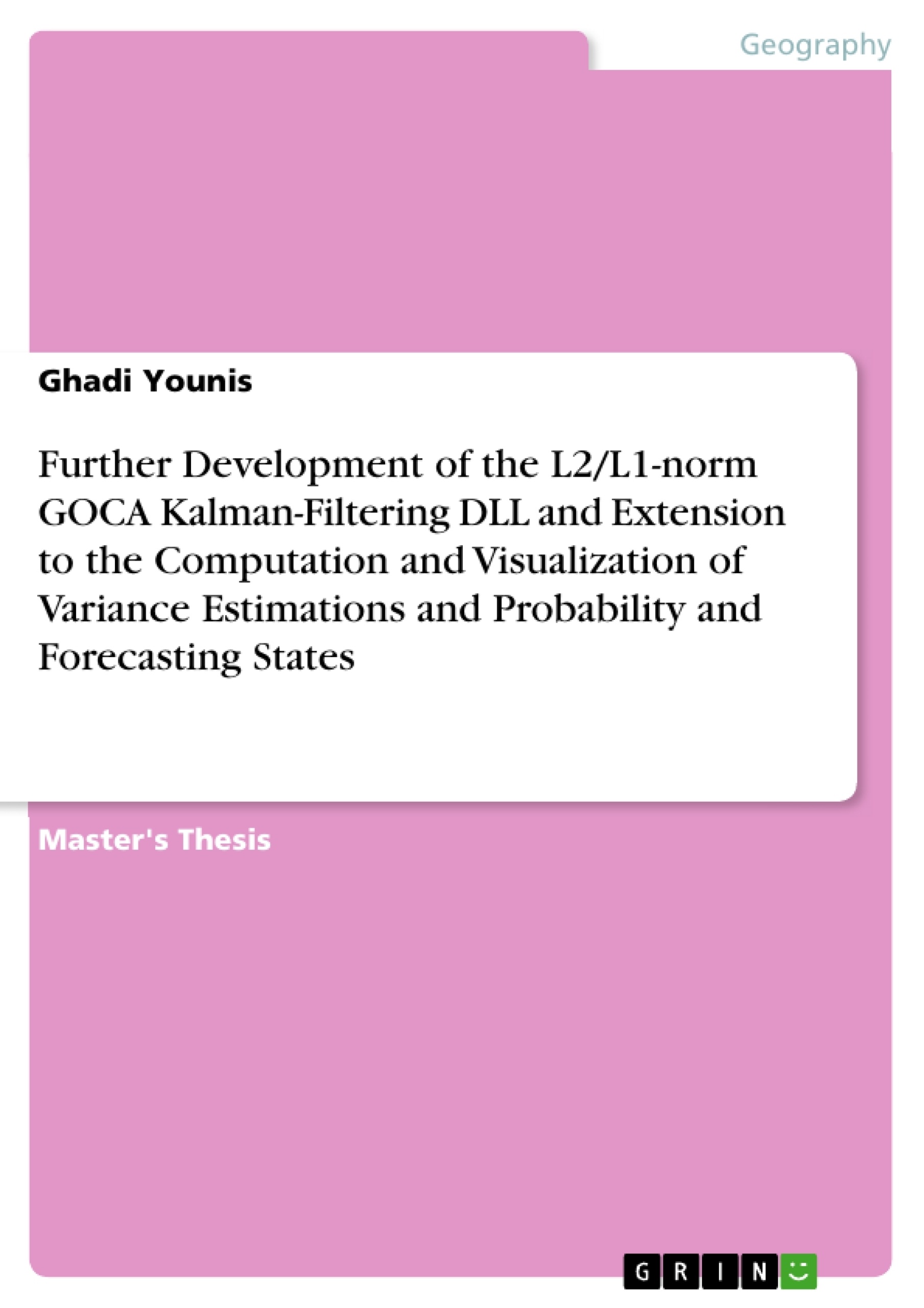As further development of GOCA- (GNSS/LPS/LS-based Online Control and Alarm Systems) software, the Kalman filter was developed as additional module to monitor besides pure object point displacement also the velocity and the acceleration in a specified time interval. In this Master thesis the Kalman filter algorithm is modified, and additional capabilities are added. The additional capabilities include; first, a forecasting of expected displacement, velocity and acceleration to future. Second, computing the time at which the point displacement and velocity is expected to exceed the given critical values.
Two estimation algorithms are used in the GOCA-Kalman filtering; first, least squares adjustment (L2-norm estimation). Second, L1-estimation. Data analysis of given projects were to be carried out and compared using both adjustment algorithms.
To design and develop the GOCA-Kalman filter four steps are applied; first step, the GOCA-Kalman filter is realized and tested using MATLAB to create the mathematical algorithm and test the results of standard point given displacement, e.g. constant velocity displacement , parabola displacement, etc . Second step, a VC++ dynamic link library (.dll) is created. Third step, the DLL file was embedded in the GOCA software by calling the DLL file and its related libraries. And forth step, the Kalman filter graphics part had to be modified to show the state vector components (displacement, velocity, and acceleration) with their standard deviations, and additional the forecasted value and its standard deviation would be shown in the graphics part.
Additional work is added to this master thesis to make artificial displacement GKA-files (GNSS/LPS/LS input files in the GOCA-software), where points displacements with linear, parabola etc are created. The software was realized using MATLAB GUI and named GKA-create.
Inhaltsverzeichnis (Table of Contents)
- Objectives
- Further Development
- Data Analysis and Testing
- Implementation into the GOCA Software
Zielsetzung und Themenschwerpunkte (Objectives and Key Themes)
This Master thesis focuses on further developing the GOCA Kalman-filtering DLL, integrating it into the GOCA software, and enhancing its capabilities for deformation analysis. The primary objectives are to improve the existing L1/L2-norm Kalman-filter DLL, implement variance estimations and probabilities, and enable forecasting of state vector quantities. Key themes include:- Improving and extending the Kalman-filter DLL for real-time deformation monitoring
- Integrating robust estimation techniques (L1-norm and L2-norm) for precise displacement analysis
- Computing and visualizing variance estimations for state vector quantities (displacement, velocity, acceleration)
- Calculating probabilities associated with critical values of state vector quantities
- Enabling forecasting of future state vector quantities and their corresponding uncertainties
Zusammenfassung der Kapitel (Chapter Summaries)
- Objectives: This chapter introduces the GOCA (GNSS/GPS/LPS based Online Control and Alarm System) project and its applications in real-time deformation monitoring. It outlines the objectives of the Master thesis, which focuses on further developing the L1/L2-norm GOCA Kalman-filtering DLL and its integration into the GOCA software.
- Further Development: This chapter delves into the specific technical details of the Kalman-filter DLL, outlining the mathematical models implemented in the algorithm. It covers the testing and improvement of the existing L1/L2-norm Kalman-filter DLL, including documentation of the theoretical developments and practical results.
- Data Analysis and Testing: This chapter discusses the data analysis and testing conducted to evaluate the performance of the improved Kalman-filter DLL. It explores the use of MATLAB and GOCA-simulation software for control and test computations, and presents the findings and reference examples.
- Implementation into the GOCA Software: This chapter describes the implementation of the Kalman-filter DLL into the GOCA software, highlighting the modifications and adjustments made to the graphical interface. It also details the integration process and the documentation of the respective manual parts.
Schlüsselwörter (Keywords)
The primary keywords and focus topics of this Master thesis include GOCA, Kalman filtering, GNSS/GPS/LPS, L1-norm, L2-norm, deformation monitoring, variance estimation, probability, forecasting, real-time analysis, and geotechnical structures. The research focuses on developing and integrating a robust Kalman-filter DLL into the GOCA system for accurate and reliable deformation analysis in various applications, particularly those involving geotechnical monitoring.- Citar trabajo
- Ghadi Younis (Autor), 2006, Further Development of the L2/L1-norm GOCA Kalman-Filtering DLL and Extension to the Computation and Visualization of Variance Estimations and Probability and Forecasting States, Múnich, GRIN Verlag, https://www.grin.com/document/276794



